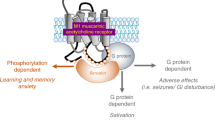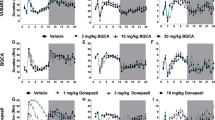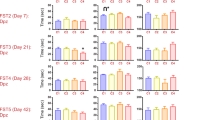Abstract
Among the five different muscarinic receptors that have been cloned and characterized, M2 and M4 receptors are localized both post- and presynaptically and are believed to have a pronounced autoreceptor role. The functional importance of these receptors in the regulation of acetylcholine release in the hippocampus and in cognitive processes was investigated by using M2 and M4 receptor single knockout (KO) as well as M2/M4 receptor double KO mice. We found profound alterations in acetylcholine homeostasis in the hippocampus of both M2- and M4-KO mice as well as of the combined M2/M4-KOs, as assessed by in vivo microdialysis. Basal acetylcholine efflux in the hippocampus was significantly increased in M4-KO and was elevated further in M2/M4-KOs. The increase in hippocampal acetylcholine induced by local administration of scopolamine was markedly reduced in M2-KO and completely abolished in M2/M4-KOs. In M2-KO and much more in M2/M4-KOs, the increase in hippocampal acetylcholine triggered by exposure to a novel environment was more pronounced both in amplitude and duration, with a similar trend observed for M4-KOs. Dysregulation of cholinergic function in the hippocampus, as it could result from perturbed autoreceptor function, may be associated with cognitive deficits. Importantly, M2- and M2/M4-KO, but not M4-KO, animals showed an impaired performance in the passive avoidance test. Together these results suggest a crucial role for muscarinic M2 and M4 receptors in the tonic and phasic regulation of acetylcholine efflux in the hippocampus as well as in cognitive processes.
This is a preview of subscription content, access via your institution
Access options
Subscribe to this journal
Receive 12 print issues and online access
$259.00 per year
only $21.58 per issue
Buy this article
- Purchase on Springer Link
- Instant access to full article PDF
Prices may be subject to local taxes which are calculated during checkout




Similar content being viewed by others
References
Raiteri M, Marchi M, Paudice P . Presynaptic muscarinic receptors in the central nervous system. Ann NY Acad Sci 1990; 604: 113–129.
Levey AI . Immunological localization of m1–m5 muscarinic acetylcholine receptors in peripheral tissues and brain. Life Sci 1993; 52: 441–448.
Sarter M, Bruno JP . Cognitive functions of cortical acetylcholine: toward a unifying hypothesis. Brain Res Brain Res Rev 1997; 23: 28–46.
Perry E, Walker M, Grace J, Perry R . Acetylcholine in mind: a neurotransmitter correlate of consciousness? Trends Neurosci 1999; 22: 273–280.
McGaughy J, Everitt BJ, Robbins TW, Sarter M . The role of cortical cholinergic afferent projections in cognition: impact of new selective immunotoxins. Behav Brain Res 2000; 115: 251–263.
Aubert I, Araujo DM, Cecyre D, Robitaille Y, Gauthier S, Quirion R . Comparative alterations of nicotinic and muscarinic binding sites in Alzheimer's and Parkinson's diseases. J Neurochem 1992; 58: 529–541.
Quirion R, Aubert I, Lapchak PA, Schaum RP, Teolis S, Gauthier S et al. Muscarinic receptor subtypes in human neurodegenerative disorders: focus on Alzheimer's disease. Trends Pharmacol Sci 1989; (Suppl 1): 80–84.
Levey AI . Muscarinic acetylcholine receptor expression in memory circuits: implications for treatment of Alzheimer disease. Proc Natl Acad Sci USA 1996; 93: 13541–13546.
Gomeza J, Zhang L, Kostenis E, Felder C, Bymaster F, Brodkin J et al. Enhancement of D1 dopamine receptor-mediated locomotor stimulation in M4 muscarinic acetylcholine receptor knockout mice. Proc Natl Acad Sci USA 1999; 96: 10483–10488.
Gerber DJ, Sotnikova TD, Gainetdinov RR, Huang SY, Caron MG, Tonegawa S . Hyperactivity, elevated dopaminergic transmission, and response to amphetamine in M1 muscarinic acetylcholine receptor-deficient mice. Proc Natl Acad Sci USA 2001; 98: 15312–15317.
Eglen RM, Choppin A, Watson N . Therapeutic opportunities from muscarinic receptor research. Trends Pharmacol Sci 2001; 22: 409–414.
Felder CC . Muscarinic acetylcholine receptors: signal transduction through multiple effectors. FASEB J 1995; 9: 619–625.
Wess J . Molecular biology of muscarinic acetylcholine receptors. Crit Rev Neurobiol 1996; 10: 69–99.
Kitaichi K, Hori T, Srivastava LK, Quirion R . Antisense oligodeoxynucleotides against the muscarinic m2, but not m4, receptor supports its role as autoreceptors in the rat hippocampus. Brain Res Mol Brain Res 1999; 67: 98–106.
Yeomans JS, Takeuchi J, Baptista M, Flynn DD, Lepik K, Nobrega J et al. Brain-stimulation reward thresholds raised by an antisense oligonucleotide for the M5 muscarinic receptor infused near dopamine cells. J Neurosci 2000; 20: 8861–8867.
Hamilton SE, Loose MD, Qi M, Levey AI, Hille B, McKnight GS et al. Disruption of the m1 receptor gene ablates muscarinic receptor-dependent M current regulation and seizure activity in mice. Proc Natl Acad Sci USA 1997; 94: 13311–13316.
Gomeza J, Shannon H, Kostenis E, Felder C, Zhang L, Brodkin J et al. Pronounced pharmacologic deficits in M2 muscarinic acetylcholine receptor knockout mice. Proc Natl Acad Sci USA 1999; 96: 1692–1697.
Forster GL, Yeomans JS, Takeuchi J, Blaha CD . M5 muscarinic receptors are required for prolonged accumbal dopamine release after electrical stimulation of the pons in mice. J Neurosci 2002; 22: RC190.
Yamada M, Miyakawa T, Duttaroy A, Yamanaka A, Moriguchi T, Makita R et al. Mice lacking the M3 muscarinic acetylcholine receptor are hypophagic and lean. Nature 2001; 410: 207–212.
Yamada M, Lamping KG, Duttaroy A, Zhang W, Cui Y, Bymaster FP et al. Cholinergic vasodilation of cerebral blood vessels is abolished in M5 muscarinic acetylcholine receptor knockout mice. Proc Natl Acad Sci USA 2001; 98: 14096–14101.
Bymaster FP, Carter PA, Zhang L, Falcone JF, Stengel PW, Cohen ML et al. Investigations into the physiological role of muscarinic M2 and M4 receptor subtypes using receptor knockout mice. Life Sci 2001; 68: 2473–2479.
Zhang W, Basile AS, Gomeza J, Volpicelli LA, Levey AI, Wess J . Characterization of central inhibitory muscarinic autoreceptors by the use of muscarinic acetylcholine receptor knock-out mice. J Neurosci 2002; 22: 1709–1717.
Nomikos GG, Arborelius L, Svensson TH . The novel 5-HT1A receptor antagonist (S)-UH-301 prevents (R)-8-OH-DPAT-induced decrease in interstitial concentrations of serotonin in the rat hippocampus. Eur J Pharmacol 1992; 216: 373–378.
Zis AP, Nomikos GG, Brown EE, Damsma G, Fibiger HC . Neurochemical effects of electrically and chemically induced seizures: an in vivo microdialysis study in the rat hippocampus. Neuropsychopharmacology 1992; 7: 189–195.
Pohorecki R, Head R, Domino EF . Effects of selected muscarinic cholinergic antagonists on [3H]acetylcholine release from rat hippocampal slices. J Pharmacol Exp Ther 1988; 244: 213–217.
Day J, Damsma G, Fibiger HC . Cholinergic activity in the rat hippocampus, cortex and striatum correlates with locomotor activity: an in vivo microdialysis study. Pharmacol Biochem Behav 1991; 38: 723–729.
Moor E, Schirm E, Jacso J, Westerink BH . Effects of neostigmine and atropine on basal and handling-induced acetylcholine output from ventral hippocampus. Neuroscience 1998; 82: 819–825.
Nilsson OG, Leanza G, Bjorklund A . Acetylcholine release in the hippocampus: regulation by monoaminergic afferents as assessed by in vivo microdialysis. Brain Res 1992; 584: 132–140.
Rouse ST, Marino MJ, Potter LT, Conn PJ, Levey AI . Muscarinic receptor subtypes involved in hippocampal circuits. Life Sci 1999; 64: 501–509.
Rouse ST, Edmunds SM, Yi H, Gilmor ML, Levey AI . Localization of M2 muscarinic acetylcholine receptor protein in cholinergic and non-cholinergic terminals in rat hippocampus. Neurosci Lett 2000; 284: 182–186.
Vannucchi MG, Pepeu G . Muscarinic receptor modulation of acetylcholine release from rat cerebral cortex and hippocampus. Neurosci Lett 1995; 190: 53–56.
McKinney M, Miller JH, Aagaard PJ . Pharmacological characterization of the rat hippocampal muscarinic autoreceptor. J Pharmacol Exp Ther 1993; 264: 74–78.
Vizi ES, Kiss JP . Neurochemistry and pharmacology of the major hippocampal transmitter systems: synaptic and nonsynaptic interactions. Hippocampus 1998; 8: 566–607.
Dorje F, Wess J, Lambrecht G, Tacke R, Mutschler E, Brann MR . Antagonist binding profiles of five cloned human muscarinic receptor subtypes. J Pharmacol Exp Ther 1991; 256: 727–733.
Kopf SR, Buchholzer ML, Hilgert M, Loffelholz K, Klein J . Glucose plus choline improve passive avoidance behaviour and increase hippocampal acetylcholine release in mice. Neuroscience 2001; 103: 365–371.
Giovannini MG, Rakovska A, Benton RS, Pazzagli M, Bianchi L, Pepeu G . Effects of novelty and habituation on acetylcholine, GABA, and glutamate release from the frontal cortex and hippocampus of freely moving rats. Neuroscience 2001; 106: 43–53.
Inglis FM, Fibiger HC . Increases in hippocampal and frontal cortical acetylcholine release associated with presentation of sensory stimuli. Neuroscience 1995; 66: 81–86.
Acquas E, Wilson C, Fibiger HC . Conditioned and unconditioned stimuli increase frontal cortical and hippocampal acetylcholine release: effects of novelty, habituation, and fear. J Neurosci 1996; 16: 3089–3096.
Thiel CM, Huston JP, Schwarting RK . Hippocampal acetylcholine and habituation learning. Neuroscience 1998; 85: 1253–1262.
Platel A, Porsolt RD . Habituation of exploratory activity in mice: a screening test for memory enhancing drugs. Psychopharmacology (Berl) 1982; 78: 346–352.
Dai H, Krost M, Carey RJ . A new methodological approach to the study of habituation: the use of positive and negative behavioral indices of habituation. J Neurosci Methods 1995; 62: 169–174.
Vannucchi MG, Scali C, Kopf SR, Pepeu G, Casamenti F . Selective muscarinic antagonists differentially affect in vivo acetylcholine release and memory performances of young and aged rats. Neuroscience 1997; 79: 837–846.
Wilson WJ, Cook JA . Cholinergic manipulations and passive avoidance in the rat: effects on acquisition and recall. Acta Neurobiol Exp (Warsz) 1994; 54: 377–391.
Lamour Y, Bassant MH, Robert A, Joly M . Septo-hippocampal neurons in the aged rat: relation between their electrophysiological and pharmacological properties and behavioral performances. Neurobiol Aging 1989; 10: 181–186.
McDonald MP, Gleason TC, Robinson JK, Crawley JN . Galanin inhibits performance on rodent memory tasks. Ann NY Acad Sci 1998; 863: 305–322.
Croll SD, Suri C, Compton DL, Simmons MV, Yancopoulos GD, Lindsay RM et al. Brain-derived neurotrophic factor transgenic mice exhibit passive avoidance deficits, increased seizure severity and in vitro hyperexcitability in the hippocampus and entorhinal cortex. Neuroscience 1999; 93:1491–1506.
Le Pen G, Grottick AJ, Higgins GA, Martin JR, Jenck F, Moreau JL . Spatial and associative learning deficits induced by excitotoxic hippocampal damage in rats: further evaluation of an animal model of schizophrenia. Behav Pharmacol 2000; 11: 257–268.
Izquierdo I, Medina JH . Memory formation: the sequence of biochemical events in the hippocampus and its connection to activity in other brain structures. Neurobiol Learning Memory 1997; 68: 285–316.
Pitsikas N, Rigamonti AE, Cella SG, Locatelli V, Sala M, Muller EE . Effects of molsidomine on scopolamine-induced amnesia and hypermotility in the rat. Eur J Pharmacol 2001; 426: 193–200.
Giovannini MG, Bartolini L, Bacciottini L, Greco L, Blandina P . Effects of histamine H3 receptor agonists and antagonists on cognitive performance and scopolamine-induced amnesia. Behav Brain Res 1999; 104: 147–155.
Quirion R, Wilson A, Rowe W, Aubert I, Richard J, Doods H et al. Facilitation of acetylcholine release and cognitive performance by an M2-muscarinic receptor antagonist in aged memory-impaired. J Neurosci 1995; 15: 1455–1462.
Carey GJ, Billard W, Binch 3rd H, Cohen-Williams M, Crosby G, Grzelak M et al. SCH 57790, a selective muscarinic M2 receptor antagonist, releases acetylcholine and produces cognitive enhancement in laboratory animals. Eur J Pharmacol 2001; 431: 189–200.
Messer Jr WS, Miller MD . Intrahippocampal injections of gallamine impair learning of a memory task. Neurosci Lett 1988; 89: 367–372.
Daniel JM, Dohanich GP . Acetylcholine mediates the estrogen-induced increase in NMDA receptor binding in CA1 of the hippocampus and the associated improvement in working memory. J Neurosci 2001; 21: 6949–6956.
Acknowledgements
We wish to thank Chris Fibiger for his comments on this work.
Author information
Authors and Affiliations
Corresponding author
Rights and permissions
About this article
Cite this article
Tzavara, E., Bymaster, F., Felder, C. et al. Dysregulated hippocampal acetylcholine neurotransmission and impaired cognition in M2, M4 and M2/M4 muscarinic receptor knockout mice. Mol Psychiatry 8, 673–679 (2003). https://doi.org/10.1038/sj.mp.4001270
Received:
Revised:
Accepted:
Published:
Issue Date:
DOI: https://doi.org/10.1038/sj.mp.4001270
Keywords
This article is cited by
-
The anticonvulsant effect of sparteine on pentylenetetrazole-induced seizures in rats: a behavioral, electroencephalographic, morphological and molecular study
Journal of Molecular Histology (2020)
-
Impaired object-location learning and recognition memory but enhanced sustained attention in M2 muscarinic receptor-deficient mice
Psychopharmacology (2018)
-
Muscarinic receptor binding changes in postmortem Parkinson’s disease
Journal of Neural Transmission (2017)
-
Potential drug targets and treatment of schizophrenia
Inflammopharmacology (2017)
-
First insight into the proteome landscape of the porcine short posterior ciliary arteries: Key signalling pathways maintaining physiologic functions
Scientific Reports (2016)



